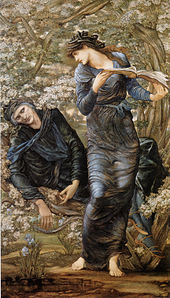Nimue
Nimue is an important figure in the Welsh and Breton legends , especially the Arthurian legend . She appears under different names, including Viviane , Elaine , Niniane , Nivian , Nyneve , Nimueh or mistress of the lake , lady of the lake , guardian of the spring , queen of the water or lady of the well . Nimue is the guardian of the lake from which Arthur received the Excalibur sword . She is considered to be Lancelot's foster mother and also the teacher or lover of the magician Merlin .
Origins
The mistress of the lake is a figure that cannot be clearly identified and appears in various forms in the Arthurian legend. Scholars see their origins in a fusion of pre-Christian traditions from Gallic , Greek, Roman and especially Celtic myths of Wales . The motif of the water, the lake or the spring is often associated with mythical, female archetypes. It is noted that the name "Viviane" may have been adopted from the Roman goddess of the forest and water. It also seems possible that the “Mistress of the Lake” and Morgan le Fay originate from the same source or tradition. The first time Avalon , a magical island in the said lake, often associated with the Lady of the Lake and Morgan le Fay, is mentioned in Geoffrey of Monmouth 's Historia Regum Britanniae ; Geoffrey testifies that the Excalibur sword was forged on Avalon and that Arthur was healed after his battle with Mordred .

The first time, Nimue does not appear in the form of a water spirit or a magical figure, but as a mortal woman. In the Du Merlin suite she appears as "Nivaine the huntress". She is a 15-year-old wild and cunning personality who is often compared in the tale to Diana , the Roman goddess of the hunt. In the story, Merlin is in love with Nivaine and she builds a house at the lake of Diana that is invisible to anyone who does not live in it. Merlin tells Nivaine how the goddess Diana killed her lover Faunus . This narrative foreshadows Merlin's own end through Nivaine.
The mistress of the lake is mentioned in other stories, such as Chrétien de Troyes' Le Chevalier de la charrette , in a more familiar and mystical way. In the story of Lancelot, she is described as the fairy of the water who raises him and gives him a ring to defend himself against magical powers. Her life with Lancelot is described in the German short story Lanzelet by Ulrich von Zatzikhoven and further elaborated in the legend of the Grail Search by Lancelot. The mistress of the lake raises Lancelot here after his father Ban was killed. It is believed that these three works stem from a lost tradition, which is best contained in Ulrich's version.
The mistress of the lake has similarities with the Nereid Thetis from Greek mythology. Like the mistress of the lake, Thetis is a water spirit who raises the greatest warrior of her time, Achilles . Thetis' husband is Peleus , while in some stories the mistress of the lake has the knight Pelleas as her lover. Thetis uses magic to make her son invulnerable and gives him a shield and armor forged by Hephaestus . Lancelot receives a ring that protects him from magic and gives the magic sword Excalibur to King Arthur. The Greek myth may therefore have inspired or influenced the Arthurian legend. The Iliad epic, in which Thetis appears, was known both in the Roman Empire , to which Britain belonged for centuries, and among the medieval scholars who wrote down the Celtic myths and lore.
The appearance of the mistress of the lake as the spirit of the water can also be found in the figure of Melusine .
See also
Web links
- Nimue in the Camelot Project at the University of Rochester (English)
Individual evidence
- ↑ SE Holbrook: Nymue, the Chief Lady of the Lake, in Malory's Le Morte d'Arthur , in: Speculum 53, 4 (1978) 761-777.
- ↑ a b W. A. Nitze: The Fountain Defended. In: Modern Philology. Vol. 7, No. 2, October 1909, ISSN 0026-8232 , pp. 145-164, JSTOR 432476 .
- ^ Luciana Percovich: Europe's First Roots. Female Cosmogonies Before the Arrival of the Indo-European Peoples. In: Feminist Theology. Vol. 13, No. 1, 2004, ISSN 0966-7350 , pp. 26-39.
- ↑ Helen Cooper: Fairy Monarchs, Fairy Mistresses: "I Am of Ane Other Countree". In: Helen Cooper: The English romance in time. Transforming motifs from Geoffrey of Monmouth to the death of Shakespeare. Oxford University Press, Oxford et al. 2004, ISBN 0-19-924886-9 , pp. 173-217.